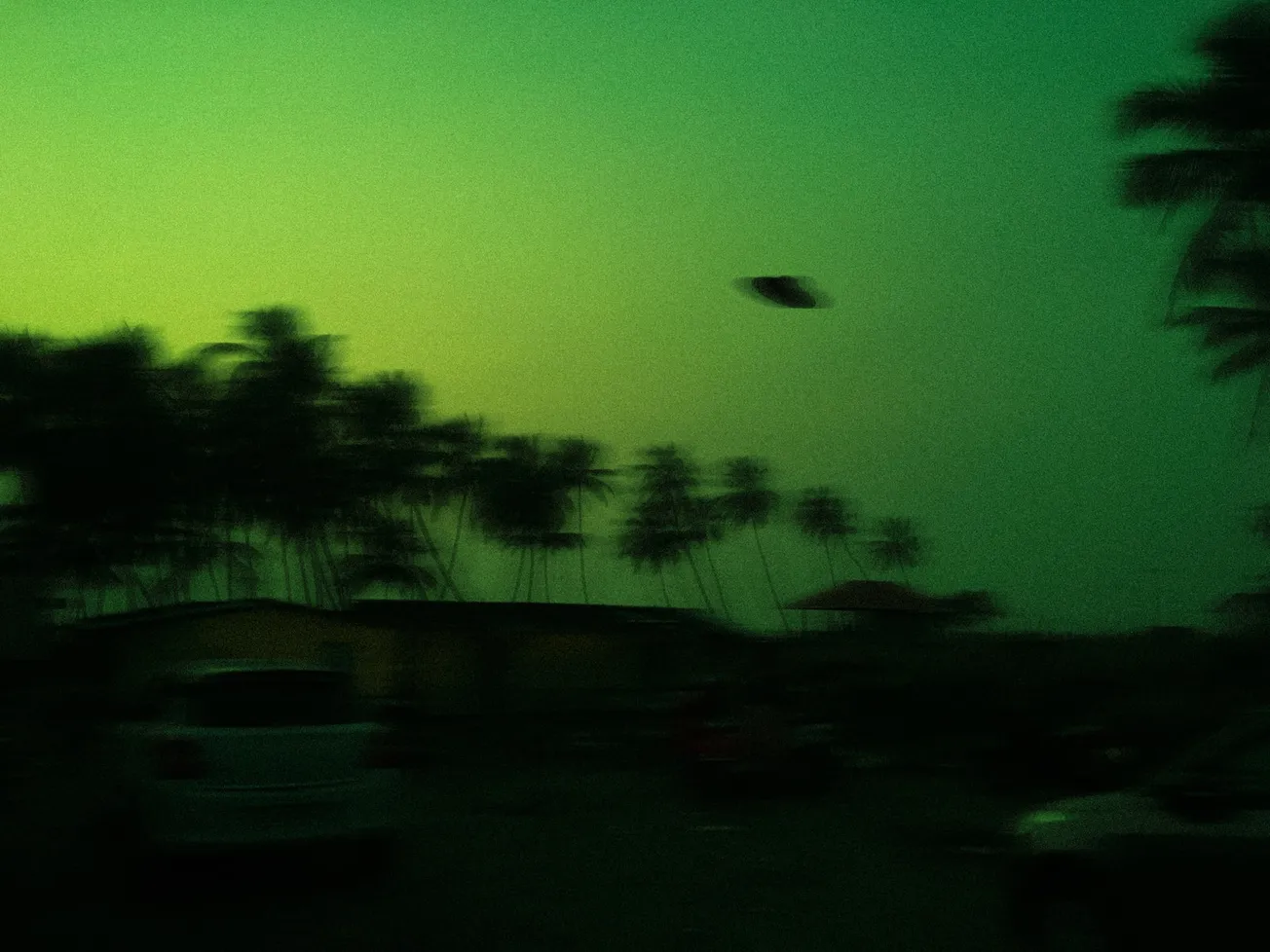Steven Tucker
Steven Tucker is a UK-based writer with over ten books to his name. His next, Hitler’s & Stalin’s Misuse of Science, comparing the woke pseudoscience of today to the totalitarian pseudoscience of the past, will be published in summer 2023.
Have you ever seen a UFO? Maybe you have: quite recently, in fact, and live on national television. Even odder, maybe you were supposed to have done so.
There has been much excited reporting this summer about the recent Congressional hearings in which US ex-intelligence officers and pilots gave breathless testimony about their supposed knowledge of a top-secret US government conspiracy to cover-up the truth about flying saucer sightings down the decades, even up to and including the recovery and spiriting away of “biologics” (i.e, ET corpses) retrieved from alleged UFO crash-sites. But what if the correct lens through which to examine UFOs is not always one of secrecy, but of publicity?
The “hullaballoon“ about the enigmatic Chinese spy-balloon shot down over America on 4 February has long since deflated, but the balloons are now back: a BBC Panorama documentary-strand investigation broadcast in Britain on 26 June has used satellite data to reveal how such devices are also present in large numbers right the way across South-East Asia, from Japan to Taiwan, and have been for at least five years now.
The BBC’s initial method of investigation was an interesting one: to identify areas where balloons might have been present, they first combed through social media and press reports from the region of supposed “UFO” sightings, reasoning these may actually have been misinterpretations of Chinese spy-balloons, and then worked the situation out further from there. Photos of such balloons looking like circular blobs of light do indeed strongly resemble classical photos of alleged flying saucers from years gone by. But is the link between the balloons and the saucers a more substantial one?
Illegal aliens
You would think spy-balloons are supposed to remain an unobserved secret, so people misinterpreting them for UFOs over Asia would appear an excellent diversionary cover for whatever their true intelligence-gathering mission may have been.
The Chinese balloon over America which produced much excited mystery-mongering amongst the general populace back in February may have been a different matter, however – here, the media panic unleashed might well have been Beijing’s true desire all along, or at least a secondary positive result for Beijing, once their device was successfully spotted. If, when you see strange flying objects in the sky, you become intellectually groomed to automatically see Red China as being responsible, not Red Mars, that may be just what Beijing wants.
Following the subsequent rapid downing of three other initially unidentified objects in North American skies, General Glen VanHerck, the USAF official in charge of domestic air-security, was specifically asked by journalists if he could rule out an extraterrestrial origin for such strange aerial invaders. “I haven’t ruled out anything,” he replied. “We’re calling them objects, not balloons, for a reason.” The actual reason for calling them by this highly generic word, however, was simply because the USAF didn’t actually yet know what they were, not because they were craft from another world.
Whilst ultimately probably mundane, the items were flying, they were objects, and they remained initially unidentified – hence, they were Unidentified Flying Objects in the literal sense of that term, not the popularly understood one of “alien spacecraft”. By 13 February, White House Press Secretary Karen Jean-Pierre felt compelled to clarify there was “no indication” of “aliens or extraterrestrials” being behind the panic, thereby ending the affair for most.
Yet a key question remained: what did the Chinese actually want? Rather than simply spying on American military installations, some commentators plausibly presumed the balloon was more truly some floating psy-ops probe intended to tease out the likely psychological reaction of both America’s generals and her general public to the unsettling presence of invading enemy air-assets.
The balloon was as large as three buses, and thus highly visible even to untrained, non-military observers. Far from a design-flaw, as might initially have been presumed, its colossal size may thus actually have been a deliberate design-feature – unlike most alien invaders, who usually prove strangely immune to being clearly photographed by purported witnesses on the ground, it looked disturbingly as if it was actively begging to be seen, by as many persons as possible.
China saucers
Although the other three much smaller objects later shot down were apparently not Chinese assets, but domestically operated scientific or commercial items, the fact they were seen at all, let alone intercepted, was a direct consequence of the first vehicle’s appearance. According to US National Security spokesman John Kirby, the main reason the USAF was now seeing more such objects was simply because “we are now looking for them”. Domestic defenders of the skies had “modified the filters” to scan more specifically for such “high altitude, small radar cross-section and low-speed objects” rather than just enemy fighter-jets or ballistic missiles as usual.
This was supposed to reassure listeners, yet Kirby’s bromides could surely have been taken contrariwise. After all, this sounded to non-specialist ears like an open admission the authorities didn’t really know what was buzzing around up there in US airspace, and had not even been bothering to fully monitor this sphere properly. That makes the USAF sound a little remiss, doubtless making some citizens feel more nervous, not less – an easy win for Beijing.
Compare this to what happened the last time the continental United States was invaded by balloons from Asia, when Imperial Japan launched around 9,000 rather useless “Fu-Go” fire-bomb balloons, a variety of incendiary paper-lantern, towards the West Coast in 1944 and 1945, during WWII. This mass assault proved ineffective for a number of reasons (for one thing, pesky winds kept blowing them badly off course) and there was only one known case of them actually causing any fatalities, after a group of picknickers in Oregon accidentally triggered one.
Japan’s aerial armada caused zero mass panic among the general public, however – as, due to a Washington-mandated media blackout, nobody outside the intelligence services actually knew about them. Hence, Tokyo’s media-monitors had no way to gauge the public’s reaction to their invasion of US airspace, something which stands in direct contrast to this February’s hyper-public panic about a single (wholly non-explosive) Beijing balloon on TV, in print and online.
Balloon fight
Balloons are indelibly associated with the early days of ufology, too. The world’s first flying saucer craze of 1947 was also partly caused by such a lighter-than-air device, when what was apparently nothing more than a specialist USAF weather-balloon crashed down upon a ranch near the small town of Roswell, New Mexico, before being initially wrongly misreported as a crashed saucer.
On 7 January 1948, meanwhile, USAF pilot Thomas F. Mantell crashed his P-51 Mustang fighter-plane when chasing a strange round white object initially identified as a UFO moving over Kentucky at a high altitude. It later transpired Mantell had (probably) been tailing an advanced US Navy Skyhook weather-balloon, items whose very existence was still then a classified military secret, explaining why neither Mantell nor ground observers had any idea what it was.
During these same early days of UFOs, though, nobody much seems to have thought strange objects in the skies were alien spacecraft, as is the automatic assumption, hope or fear of many today. According to a 14 August 1947 Gallup poll conducted in the immediate wake of history’s first ever flying saucer sighting, made by civilian pilot Kenneth Arnold over Washington State on 24 June 1947, the most common ideas about what the saucers might have been were as follows:
No answer, don’t know: 33%
Imagination, optical illusion, mirage, etc: 29%
Hoax: 10%
US secret weapon, part of atomic bomb, etc: 15%
Weather forecasting devices: 3%
Russian secret weapon: 1%
Other explanations: 9%
No aliens there, then – or Chinese. Today, the case is rather different. The initial hi-tech, balloon-like object seen in February 2023 was obviously a real, physical item, not a mirage, and the two most common explanations advanced to account for it were either ET or President Xi.
This actually represents a major propaganda victory for Beijing. If anyone had suggested the first UFOs, with their impossible maneuvers and uncanny ability to evade capture, had been Chinese-built, they would have been laughed at, for much the same reason nobody today was claiming the highly advanced 2023 balloon over America was made by villagers in Papua New Guinea.
Little yellow men
In 1947, at a time when Mao Tse-Tung’s Communists were still fighting a bitter civil war, and much of the country lay in ruins following its long-term occupation by Imperial Japan, Chinese manufacturing and science capacity was slim indeed by Western or Soviet standards. The label “Made In China” would then (quite literally in terms of ship-building, to use the old joke) have denoted “junk” status.
Foreign perceptions of Chinese technological, military and aerospace capabilities have clearly changed substantially in the last 75 or so years, therefore. Today, the 21st century Communist China of the all-powerful CCP, with its hypersonic missiles, quantum computers, advanced space-program and Orwellian methods of computerized social credit looks to outside eyes increasingly like a full-blown alien hive-mind home-world – intentionally so, perhaps, as I have myself recently argued elsewhere (see here, here and here).
If for the average casual US media consumer, “UFO” now means “Unidentified Foreign Object” (and specifically a Beijing-built one), rather than a craft from Mars or Neptune, then the Chinese have now essentially replaced extraterrestrials in this respect within plenty of ordinary people’s imaginations. For many awe-struck observers in the West and elsewhere, the ever-advancing Chinese people of the 2020s more and more seem beyond all realistic future competition, and thus really are figuratively operating on a whole other planet from the rest of us.
So, resistance to their geopolitical designs is futile! At least, that could be what Galactic Balloon-Emperor Xi wants us all to think …
Keep watching the skies!







